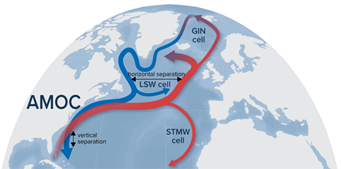

1st August 2023 (6 Topics)
Context
According to a new findings published in Nature Communications suggested that the Atlantic meridional overturning circulation (AMOC), could collapse within the next few decades— driving European weather to even greater extremes.
|
According to the latest report from the International Panel on Climate Change (IPCC) — which includes research from hundreds of scientists — the AMOC is “very likely to weaken over the 21st century” due to climate change. |
What is Atlantic Meridional Overturning Circulation (AMOC)?
- AMOC stands for Atlantic Meridional Overturning Circulation. The AMOC circulates water from north to south and back in a long cycle within the Atlantic Ocean.
- This circulation brings warmth to various parts of the globe and also carries nutrients necessary to sustain ocean life.
- The circulation process begins as warm water near the surface moves toward the poles (such as the Gulf Stream in the North Atlantic), where it cools and forms sea ice. As this ice forms, salt is left behind in the ocean water.
- Due to the large amount of salt in the water, it becomes denser, sinks down, and is carried southwards in the depths below.
- Eventually, the water gets pulled back up towards the surface and warms up in a process called upwelling, completing the cycle.
How Europe’s Climate depends on AMOC?
- The AMOC amounts to a system of currents in the Atlantic that bring warm water northwards where it then cools and sinks.
- It is a key reason why Europe’s climate has been stable for thousands of years.
- AMOC is also only one part of the wider Gulf Stream system, much of which is driven by winds that will continue to blow even if the AMOC collapses.

- Northern Europe will experience successive severe winters as subsequently attributed to a brief slowdown of the AMOC.
- At the same time heat had built up in the tropics, fuelling an unusually active June-November hurricane season in 2010.
How ocean temperatures are linked to weather?
- Over recent years Europe has witnessed some particularly unusual weather, in both winter and summer.
- At the same time, peculiar patterns of sea surface temperatures have appeared across the North Atlantic.
- Across great swathes of the ocean from the tropics to the Arctic, temperatures have persisted 1°C-2°C above or below normal levels, for months or even years on end.
- These patterns appear to exert a strong influence on the atmosphere, even influencing the path and strength of the jet stream.
Causes of the decline in AMOC:
- Due to Global Warming: The study's authors attribute the potential AMOC collapse to global warming, which accelerates the melting of Greenland ice.
- The influx of freshwater from melting ice weakens or disrupts the AMOC's normal sinking of salty water, possibly leading to its collapse.
- Indian Ocean Influence: A 2019 study suggested that the Indian Ocean may also be helping the slowing down of AMOC.
- As the Indian Ocean warms faster, it generates additional precipitation.
- With so much precipitation in the Indian Ocean, there will be less precipitation in the Atlantic Ocean, leading to higher salinity in the waters of the tropical portion of the Atlantic.
- This saltier water in the Atlantic, as it comes north via AMOC, will get cold much quicker than usual and sink faster.
Concerns associated:
- Saline species and sustaintence: This change reduces the water’s saltiness, making it less dense and harder to sink.
- Effects on Agriculture: If enough water stops sinking, then the AMOC will weaken. Depending on how much the AMOC weakens, it can change regional weather patterns, such as rainfall, and affect where and how well crops can grow.
More Articles


